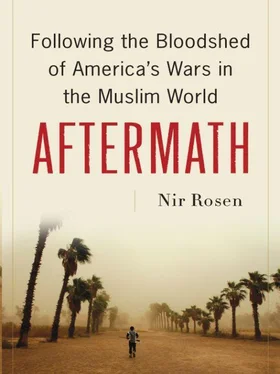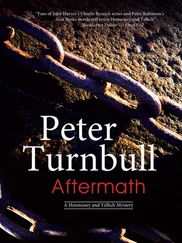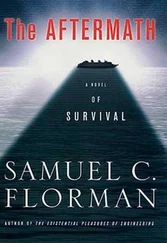By 2005 Sunnis and Shiites were using derogatory terms to refer to one another. To Shiites, Sunnis were “Saddamists” and “Nawasib.” “Saddamists” referred to Baathists and former regime loyalists, but many Shiites, especially the poor and uneducated, used it as a blanket term for all Sunnis. Shiite leaders, including Ayatollah Sistani, Ayatollah Yaqoubi, and Muqtada, used the term in their speeches to refer specifically to Salafis. Many Shiites have taken to calling all Sunnis Wahhabis, the strict brand of Islam associated with Saudi Arabia.
Extreme Sunnis believed Shiites were “ rafidha ” or “ turs .” “ Rafidha ” is technically the opposite of “Nawasib”: it means “rejectionists” and referred to those who do not recognize the Islamic caliphs and want a caliphate from the descendant of Imam Ali. It was used initially by Salafis and Wahhabis to pronounce Shiites as outside Islam, and it has become a pejorative term used the way American racists spit out the word “nigger.” “ Turs ” is the word for “shield” and refers to human shields used by the enemy infidels. It is permitted to kill these shields according to some interpretations of Islamic jurisprudence. Iraqi Salafis referred to the Iraqi Muslims they killed (such as members of the Iraqi police and army) as turs to justify killing people who were nominal Muslims but were shielding the Americans. Salafis and jihadis believed that Shiite religious leaders were supplying shields by encouraging their followers to join the Iraqi police and army.
The Arab world has always been dominated by Sunnis, who make up 85 percent of the world’s Muslims. The new Shiite Iraq was aggressive and confident, overturning the Ottoman and colonialist legacies that entrenched Sunnis. It threatened the status quo throughout the Arab world. In Syria, already viewed as dominated by the Shiite-like Alawite minority that is hated by many in the Sunni majority, the Iranians built a mosque commemorating a battle that Imam Ali lost. The unpopular Sunni regimes of Jordan, Egypt, Saudi Arabia, and elsewhere, the so-called moderate Arabs, seeing their power wane, could no longer be anti-American or anti-Israeli, having sold out on those issues and backed the Americans. Instead they were playing the sectarian card to regain the respect they lost from their population and galvanize them against a new threat. Egyptian President Hosni Mubarak accused Shiites of being fifth columnists, loyal to Iran. In Lebanon during the 2006 demonstrations that followed the publication of the Danish cartoons, Sunni clerics condemned Shiites and supported Al Qaeda in Iraq leader Abu Musab al-Zarqawi (one cleric called him “my sheikh, my emir”), perhaps hoping they could appropriate the so-called “sheikh of the slaughterers” as their own to gain more leverage against the powerful Shiite Hizballah. More ominous, in April 2006 Hizballah accused nine men of attempting to assassinate its general secretary, Sayyid Hassan Nasrallah. Hizballah said the culprits had been motivated by a desire to avenge killings of Sunnis in Iraq. In his last statement before his death, Zarqawi specifically condemned Lebanese Hizballah, making arguments that presented a Lebanese Sunni point of view.
The death of Zarqawi in an American strike in June 2006 was hailed by the Bush administration as a turning point, but the civil war had its own cruel logic and did not need Zarqawi. Instead, a new Zarqawi emerged. Sunnis began speaking of the “Shiite Zarqawi.” In the summer of 2006, rumors began spreading throughout Baghdad of a shadowy Shiite killer known as Abu Dira, a nickname meaning the Armor Bearer. In the Shiite uprisings of 2004, he was said to have held off the Americans in southern Sadr City. He earned his name either by destroying American armored vehicles or after killing an American soldier and stealing his body armor. Some rumors claimed he wore this armor at all times. Hailed by Shiites as a hero who defended them, he was also known by Sunnis as the Rusafa Butcher, a reference to the eastern half of Baghdad, where he was said to live. Another story claimed that a Sunni prison guard under Saddam called Abu Dira was notorious among Shiites for his brutality. The vengeful Shiite known as Abu Dira might have taken his nickname out of irony. All information about him was based on rumors, but he was said to be a man in his thirties called either Salim or Ismail, who lived in Sadr City but was born in the southern Shiite town of Amara. Some said he was a member of the Mahdi Army and commanded hundreds of fighters, but other sources claimed he was a renegade militiaman, out of Muqtada’s control. Some said he was a bodyguard in the former regime who had deserted and fled to Iran; others thought he had been a guard who tortured prisoners in one of Saddam’s prisons. One website claimed that he controlled the Interior Ministry’s Falcon Brigade, which kidnapped Sunnis from Baghdad’s Zafraniya district.
It was said that every time there was a terror attack against Shiites he counted the dead and killed an equal number of Sunnis, although by other accounts he killed a higher ratio of Sunnis when he extracted vengeance. He was said to kill dozens of Sunnis every day in a remote part of Sadr City called Sadda, and he was also said to have threatened to fill the craters left from car bombs in Sadr City with the bodies of Sunnis. Some Sunni sources believed he was obeying the fatwa issued by Ayatollah Kadhim al-Haeri in Iran, who was Muqtada’s erstwhile backer, urging Shiites to kill Sunnis and former Baathists in particular. One Sunni website claimed he had taken an oath to slaughter a camel and feed the poor people of Sadr City after he had killed Sunni politician Adnan al-Dulaimi. A popular radical Sunni line is, “Our dead are in paradise and your dead are in the hell.” Abu Dira changed that, telling Sunnis, “Our dead are in paradise and your dead are in Sadda,” Sadda being the dam in eastern Baghdad where Shiite gangs dumped Sunni corpses. Although some Shiites in Baghdad cheered this legend as much as Sunnis feared him, Muqtada and the Mahdi Army denied that he even existed and claimed he had been invented by Sunnis to falsely accuse Shiites of crimes. An American operation in Sadr City in July targeted a funeral for one of Abu Dira’s relatives but failed to lead to his arrest.
Muqtada’s control over his militia was tenuous. He issued statements such as “We are the enemies of the Saddamists,” which were interpreted by his followers as a license to kill all Sunnis. The Mahdi Army was not strictly hierarchical, and Muqtada was unaware of most of its local commanders and activities. The Mahdi Army’s cells were loosely organized; many of them were composed of friends who were on local soccer teams. Sayyid Hassan Naji al-Musawi, an important Mahdi Army commander in Sadr City, had been a well-known local soccer star before the war. Different leaders of the Mahdi Army disliked one another. There were jealousies and rivalries. There was nothing stopping a group of Shiite youths from declaring that they were a Mahdi Army unit, collecting weapons, and interpreting Muqtada’s statements as they saw fit. Mahdi Army leaders could be imams, sheikhs, or local toughs called shaqis . Before the war shaqis might have been neighborhood gang leaders, but with the formation of Sunni and Shiite militias and resistance groups, they took the lead. In Baghdad and majority-Shiite towns, most of the police were Mahdi Army as well. The reasons were simple. Most poor Shiite men supported Muqtada and claimed to belong to his militia, and most Iraqi police were poor Shiite men, so they were one and the same. Sunnis came to view the state as their enemy. As early as 2005, I realized that the once-confident and aggressive Sunnis were intimidated and uncertain about their fate. They worried about losing.
Читать дальше











